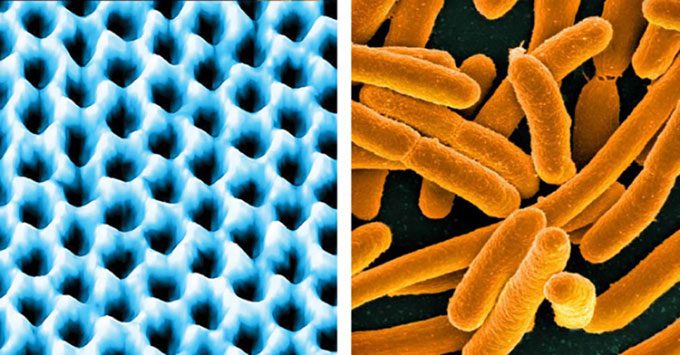The ultra-sensitive listening device developed by a research team from Delft University of Technology (TU Delft) could be key to addressing the problem of antibiotic-resistant bacteria.
The team, led by engineer Farbod Alijani, has successfully developed an ultra-sensitive listening device capable of determining whether a specific antibiotic can kill E. coli bacteria, according to a new study published in the journal Nature Nanotechnology on April 18. This tool relies on a material known as graphene to capture the incredible sounds made by bacteria as they attempt to move around.

Graphene material (left) and E. coli bacteria (right) viewed under a microscope. (Photo: Interesting Engineering)
Graphene has long been hailed as a revolutionary material for everything from solar panels to smartphone screens. Alijani describes it as “a form of carbon consisting of a single layer of atoms.” Scientists created the first useful version of this material in 2004 and won the Nobel Prize for their discovery just six years later.
“It is very strong with excellent electrical and mechanical properties. Some people call graphene the miracle material of the 21st century because of these properties. It is also extremely sensitive to external forces. This makes the material perfect for detecting movement from tiny appendages – known as flagella – that E. coli uses to move,” Alijani stated.
The sound produced by E. coli when it moves is at least 10 billion times smaller than the punch of a boxing champion. However, these “ultra-tiny flagellar beats” at the nanoscale can be converted into “music” by graphene, the research team explained.
The “flagellar beats” of E. coli recorded by the ultra-sensitive listening device. (Video: Cees Dekker Lab)
Alijani collaborated with nanobiologist Cees Dekker to develop the ultra-sensitive graphene-based listening device. The project yielded truly impressive results right from the initial experiments.
“When a bacterium attaches to the surface of graphene, it creates random oscillations with amplitudes as low as a few nanometers that we can detect,” Dekker said. “With the ultra-sensitive listening device, we can hear the sound of a single bacterium.”
E. coli is very small but extremely dangerous, causing the deaths of hundreds of thousands of people worldwide and making hundreds of millions more ill. More concerning is that they are developing resistance to antibiotics much faster than we can develop new antibiotics.
This work is clearly useful in determining whether an antibiotic is effective in eliminating bacterial infections. If a drug-resistant strain of E. coli emerges, graphene will detect no change in the sound of the flagella striking the thin layer of carbon atoms. If the antibiotic works, the flagellar beats will slow down and fade until the noise completely stops.
In the next phase, Alijani’s team plans to optimize the platform and test it based on various pathogenic samples. Their ultimate goal is to create an effective diagnostic toolkit for the rapid detection of antibiotic resistance in clinical practice.


















































